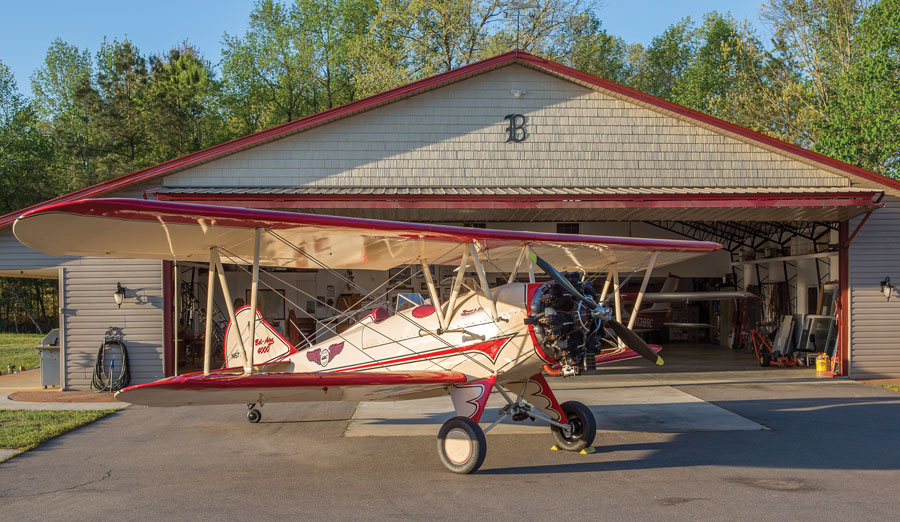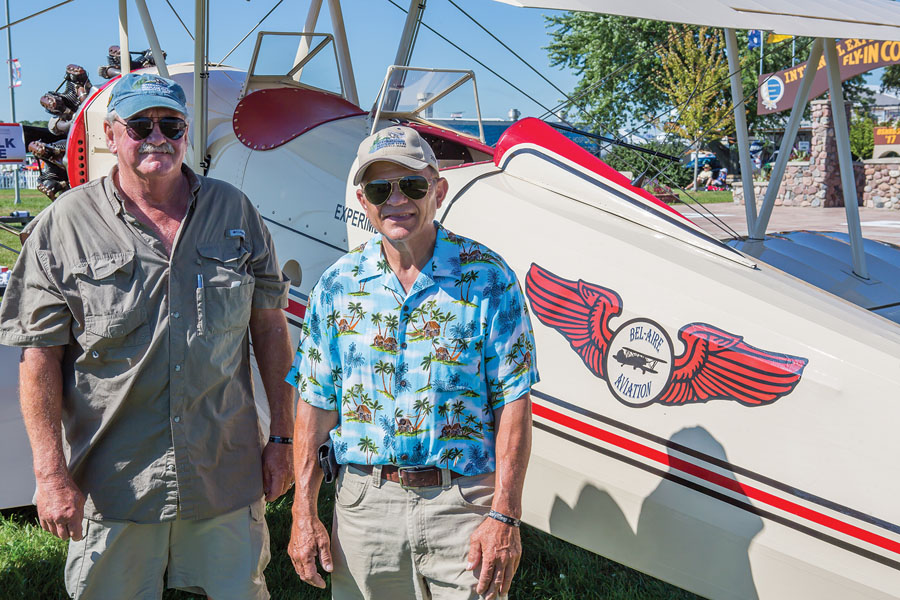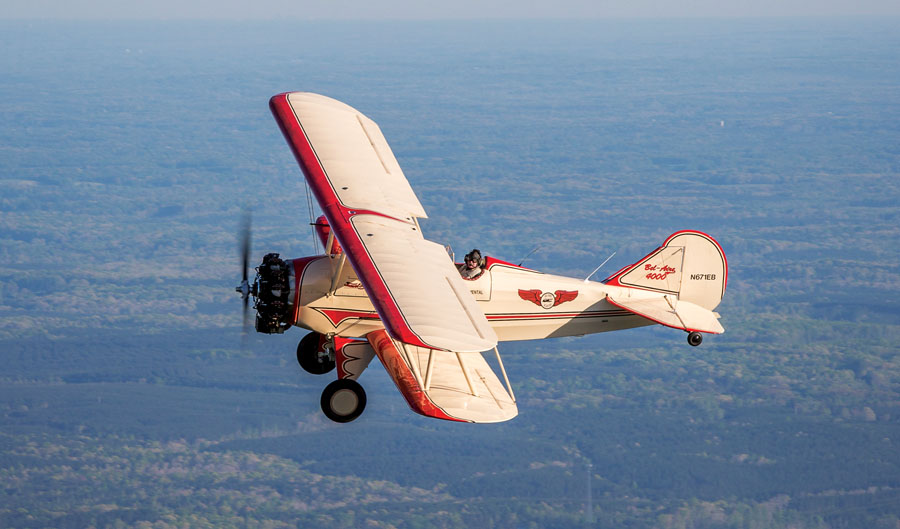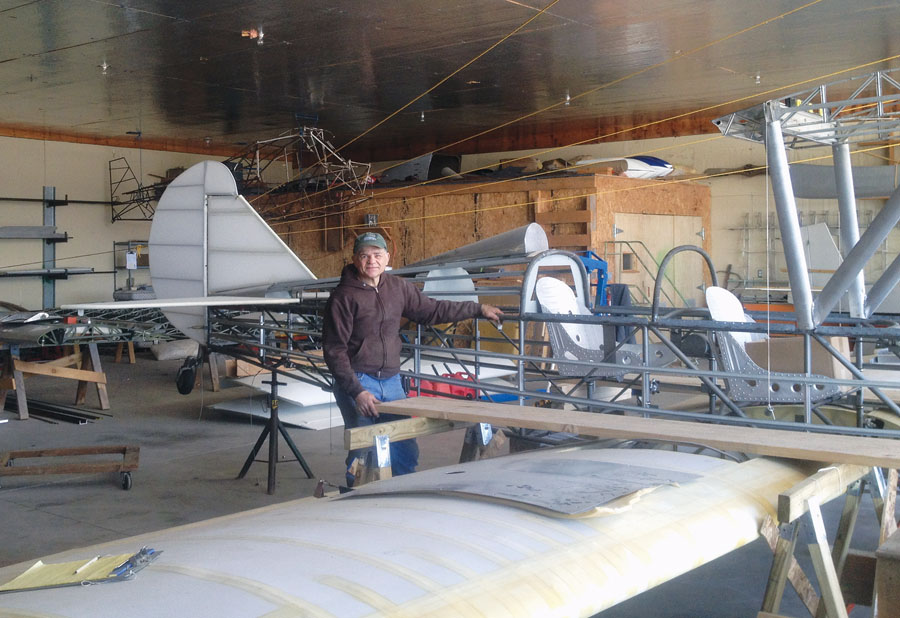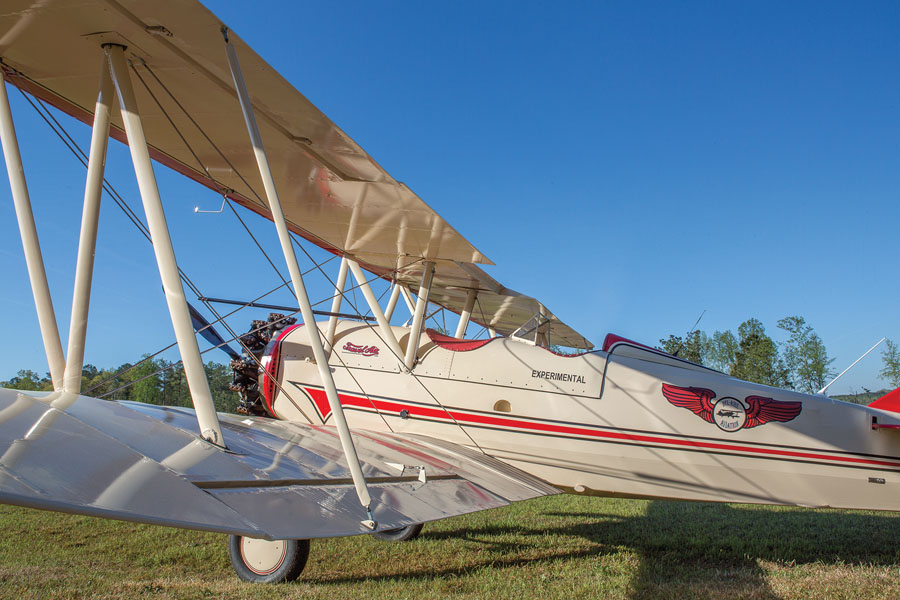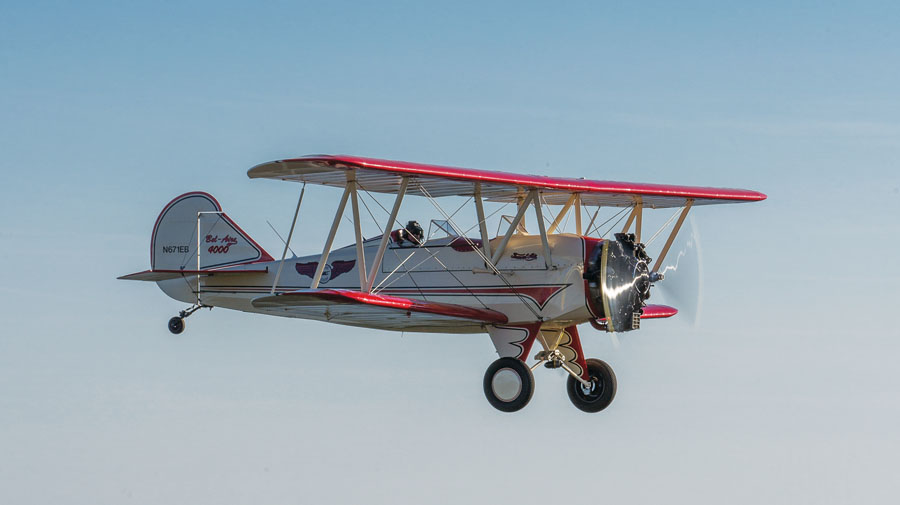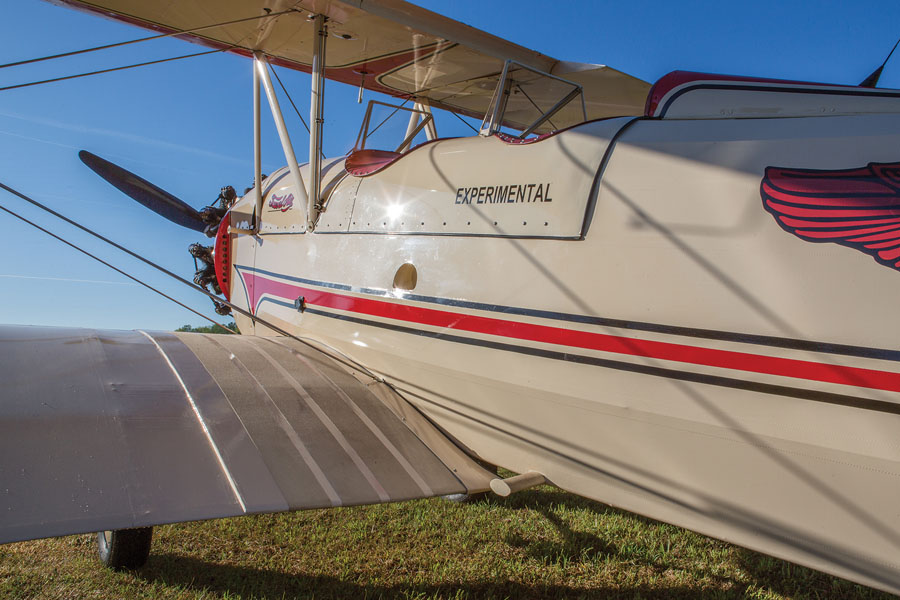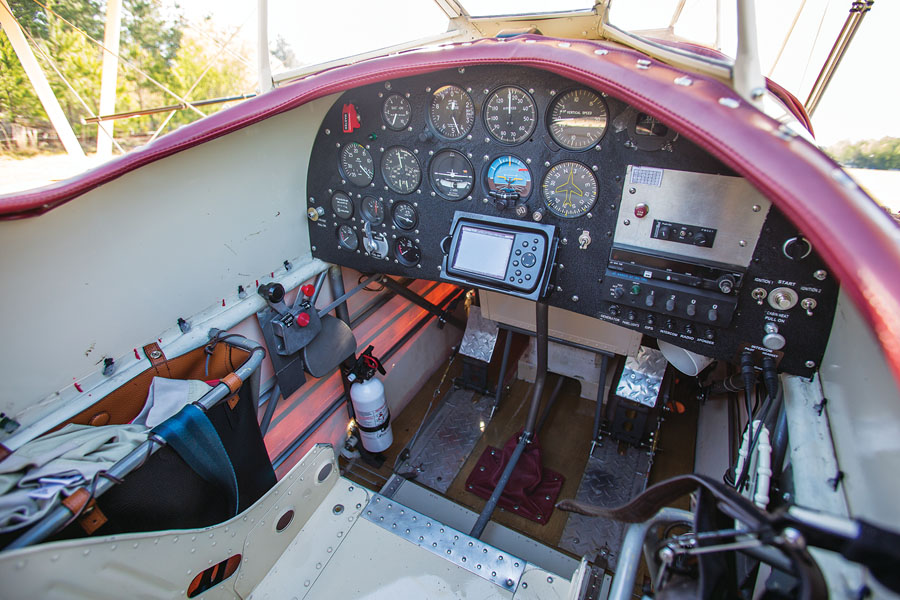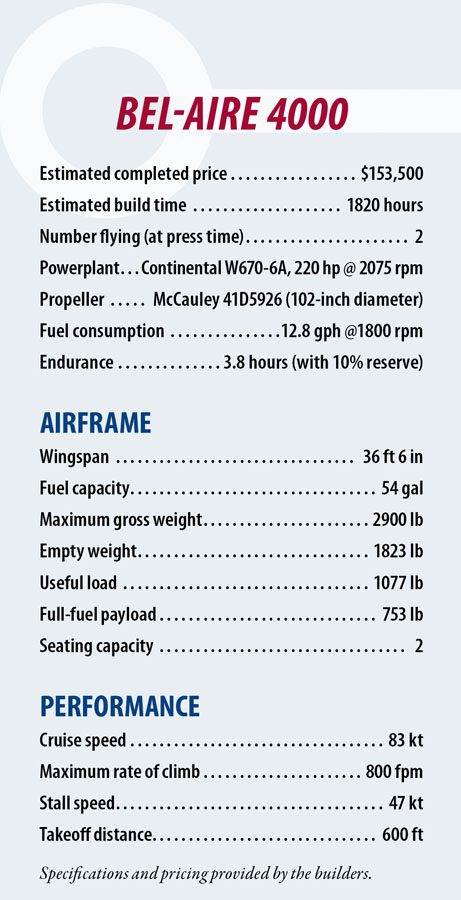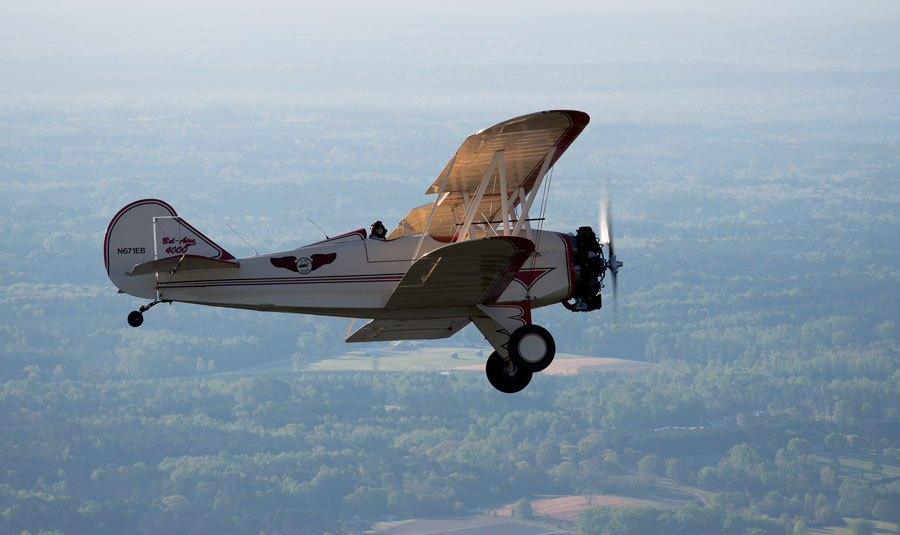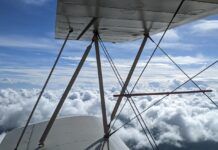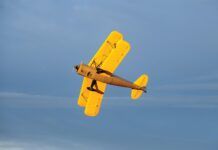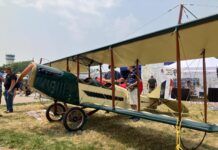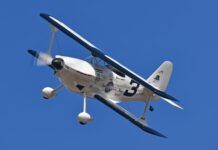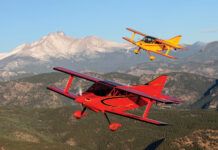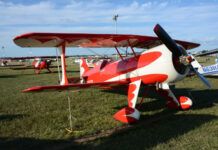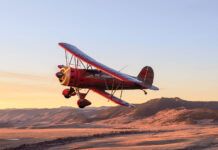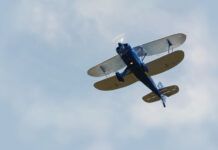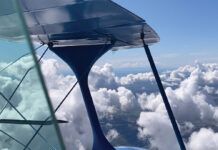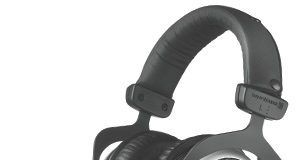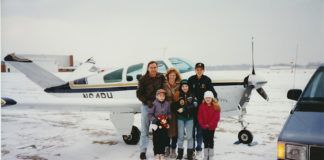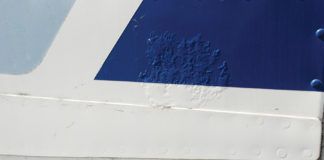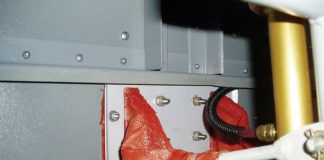“Dimensionally, the Bel-Aire 4000 is the same as a 1929 Travel Air 4000,” said Bill Bardin, who built the plane with his partner, Gerald “Gerry” Belcher in Belcher’s shop in upstate New York. The look-alike biplane represents the best of old-school homebuilding from the early 1950s, when barnyard engineers united parts of factory-made airplanes to new construction. Bardin calls it a “design-build” homebuilt, now an outlier in the realm of experimental aircraft that amateurs build from kits or plans.
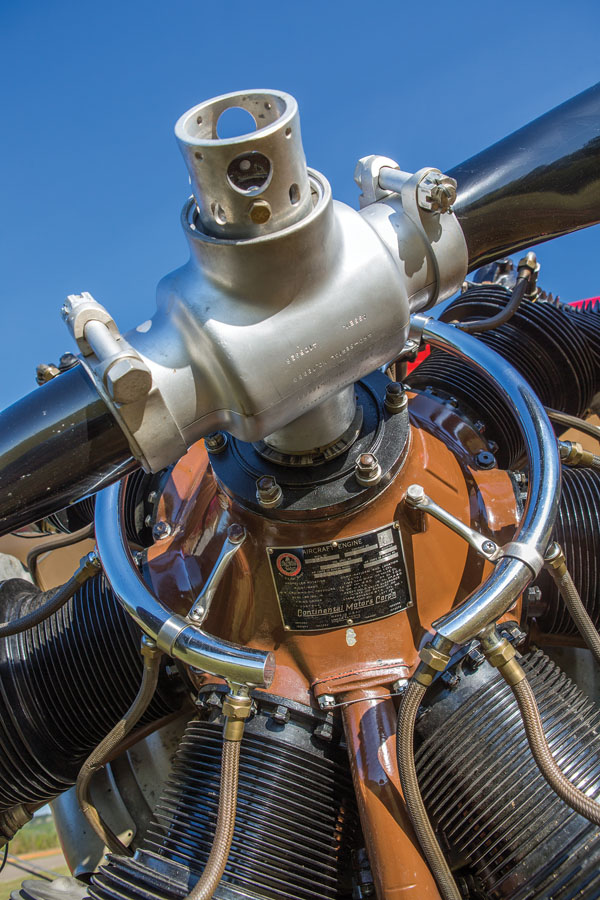
The 220-hp Continental W670 and factory-adjustable prop form a certification combination that required a 25-hour Phase I test period.
Bardin and Belcher harmonized a quick compilation of the Bel-Aire’s anatomy: Sprouting from its new steel-tube fuselage and tail feathers, its lower wings are from a Piper PA-22 Colt, and its upper wings are from a Piper PA-12 Super Cruiser. The upper ailerons are slaved to the lower, which results in delightfully light controls, said Bardin, who made the Bel-Aire’s first flight on June 14, 2017, his 64th birthday.
“The original Travel Airs had a nine-cylinder, 520-pound, 200-hp Wright J5 radial engine,” said Belcher. The Bel-Aire’s seven-cylinder, 450-pound 220-hp Continental W670 didn’t exist then, but few can find—or afford—a running Wright today. Overall, the Bel-Aire is 40 pounds lighter than the original Travel Air 4000.
The biplane’s journey began in 2004, “when a fellow down in Durham, North Carolina, Joe Hunt, overhauled two [220-hp Continental W670] cores for us into one engine,” said Bardin. One was built for a WW-II M2 light tank, and Hunt combined them in “a certified engine and prop combination,” so they only had a 25-hour Phase I test period.
“It was a lot of fun, and it flies great!” said Bardin, adding that he completed the test period in about two weeks, just before EAA AirVenture Oshkosh 2017. “My brother and I came here in 10.5 hours and three fuel stops. I usually cruise around 90 mph for fuel efficiency. It’s got a 2900-pound gross and a big, wide CG window, but you can’t carry a lot of baggage because there’s no place to put it.”
Bardin, a pilot since 1975, has owned a bunch of airplanes. “Old airplanes have always intrigued me,” he said, especially the amphibious Republic Seabee. That’s how he met Belcher, whose shop and grass strip, about 35 miles from Rochester, New York, is not far from Bardin’s summer home. (He winters at a fly-in community in North Carolina.)
“We met through another Seabee owner,” said Belcher, an A&P with inspection authorization. “It’s a pretty small community, and there aren’t many mechanics around that know the airplane, so we came together working on Seabees 15 or 18 years ago.”
It seems the perfect partnership. “Bill’s an engineer type with several thousand hours of flying, and I’m the A&P type. I’m a pilot, but we’re at different levels. His father was a Piper dealer. He and his three brothers were raised with airplanes,” said Belcher.
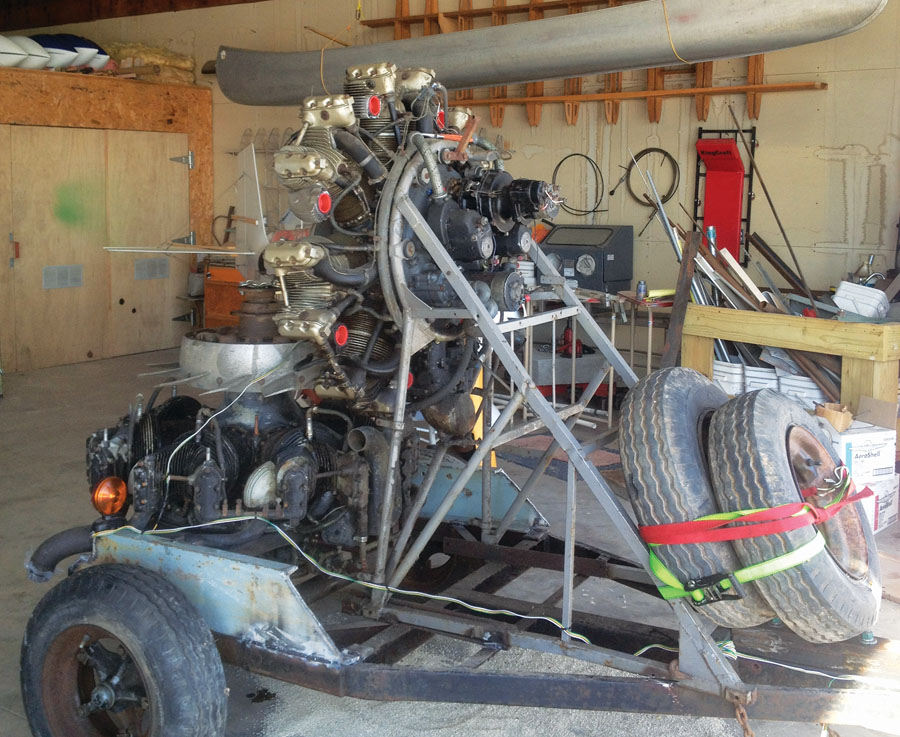
Joe Hunt combined two W670 Continental radials, one meant for a WW-II tank, into the Bel-Aire’s powerplant.
“I’ve been in construction my whole life; a pipe welder and instructor, my part is the metal work,” said Bardin. “Gerry is the wrencher. Nick Fratengello, an older fella, is the third member of the team, an artist” who works with Ceconite fabric and Air-Tech Coatings. Bardin’s brother Mike “is into computers, and he came up with the Bel-Aire 4000 artwork.”
Beginnings
Bardin and Belcher started work on the Bel-Aire’s airframe in 2008, but the project really began 20 years ago, when they built a replica Travel Air 2000 with a V-8 engine. “It was the prototype, serial number 1,” said Bardin. “We learned a lot of lessons from that airplane. It had wooden wings and was quite heavy.”
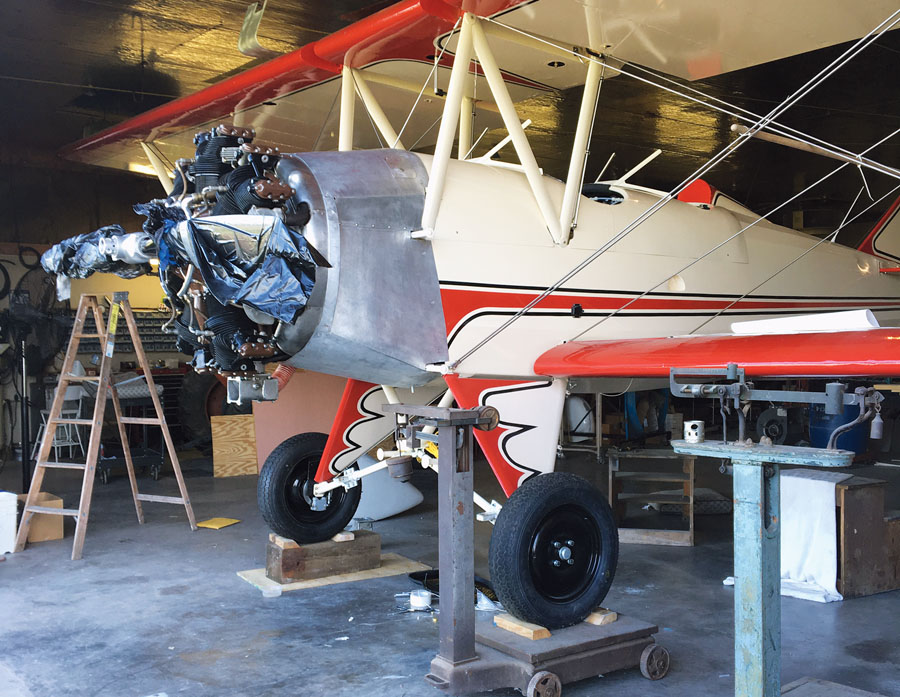
With the engine mounted, Belcher and Bardin weigh the Bel-Aire 4000, which tipped the scales at 1823 pounds empty.
That project began when Belcher bought a 1926 Travel Air 2000 in Mississippi and trucked it home. “A big investment, my wife looks at it, wings off on the truck, and says, ‘That’s great.’ First thing I did was take it apart. Then she sees the pieces in the hangar and asks, ‘What happened?'”
It was all part of the grand plan. “I built jigs for all the pieces, the fuselage, landing gear, and tail feathers, and then restored the original; it’s at the Hammondsport museum right now. Then I built a replica of that airplane with wood wings and wooden tail feathers,” said Belcher.
Given the cost of restoring the original’s “100-horse OXX-6 Curtiss engine,” he replaced it with a 350 Chevy V-8 and reduction gearing from an airboat. “This was right out of the box from Jasper Engine. Nothing fancy. Iron heads, short stacks, Holley carburetor. It ran great, and we put about 650 hours on it,” Belcher said.
“But it flew like a dump truck. It took as much effort to get it out of a maneuver as it did to get it into it.” Replicas built without plans get heavy, said Belcher. “You decide to put a heavier bolt there, let’s leave this a bit bigger. The airplane came out 400 pounds heavier than the original” Travel Air 2000.
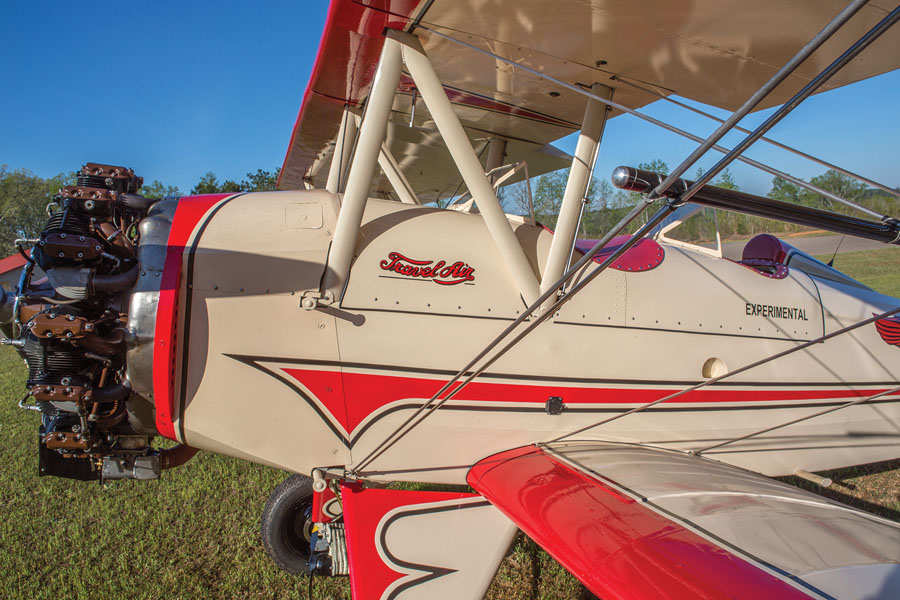
Building economically, they used round flying wires of the same alloy as the more expensive streamline versions.
Building the Bel-Aire 4000
After selling the Travel Air 2000, Belcher and Bardin decided to build a better one. At a quick glance, the resulting Bel-Aire 4000 looks like an antique Travel Air. “We replicated it dimensionally and aesthetically, but internally, it is a modern airplane,” said Belcher. The primary difference between the Travel Air 2000, 3000, and 4000 was the engine and wings attached to a common fuselage. Belcher and Bardin did essentially the same thing with the Bel-Aire 4000, using modern materials.
Bardin TIG welded the fuselage using 4130 chromoly steel. “Back in the day, they used heavy 1025 steel,” said Belcher. The original tail feathers were a combination of metal with wood formers. “Ours are all TIG-welded aluminum.” They changed the trim from “a cable and spring-loaded clicker system to a more conventional rotary system, like a Cessna.”
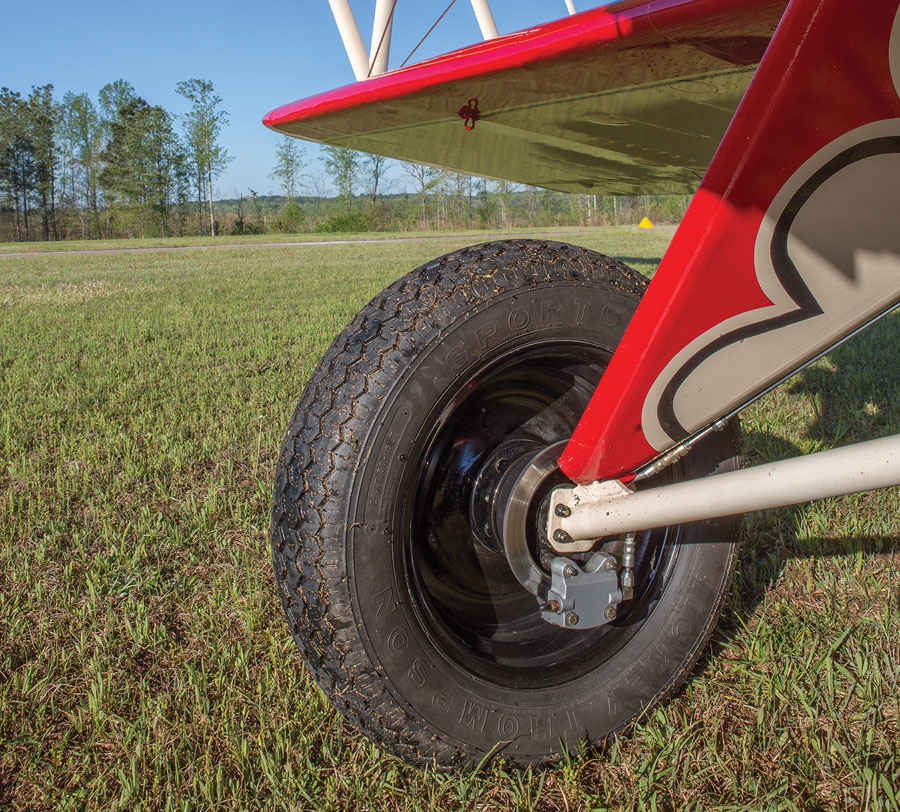
Grove Aircraft designed the hubs that connect the brakes to the spun-aluminum rims that started life as spare tires for Ford Mustangs.
“Duplicating wood wings is very labor intensive and very specific because of weight,” said Belcher, so they went with the flap-free, fabric-covered, all-metal Piper wings, building a center section with fuel tank for the upper wings. They kept the Super Cruiser’s fuel tanks, which work with the center section tank for 54 gallons total. They turned the right low-wing tank into a storage locker, and the left tank bay into a reinforced wing walk, said Belcher.
Unlike its predecessor, the Bel-Aire’s custom aluminum interplane struts have no adjustments. Bardin welded them to establish the correct angle of incidence and dihedral. The original only had lower ailerons. The slaved upper and lower ailerons “give it very precise, easy controllability,” said Belcher. “The airplane pretty much flies hands off.”
With two different sets of “wings and a different stagger, the aerodynamics that defined the CG was a question,” said Belcher. His younger brother Mike, an Air Force engineer and retired B-52 pilot, “worked out all the numbers for us.” With a different chord, the Piper wings give the Bel-Aire more wing area than the original, so he adjusted the location of the wing mounts to make it all work. “Mike also figured out the engine mount to put the CG in the right place.”
Working on a budget, Belcher and Bardin made their own flying wires. “We researched the alloys and had the threads rolled” on round stock rather than streamlined. “We were investing money in the project, and we didn’t know if it was going to fly or not.” Store-bought streamlined flying wires don’t come cheap, said Belcher, and making them with the proper materials and processes was an economy that didn’t sacrifice safety or seriously affect performance.” All biplanes are draggy, said Bardin, and with the fatter Piper wings, the airplane tends to be a bit slower and cruises between 90 and 95 mph.
Landing Gear and Brakes
The only serious trial-and-error engineering challenge Belcher and Bardin faced was the landing gear. “Once we started taxiing, the geometry wasn’t quite working for the steering, the tailwheel, and the brakes,” said Bardin. “We didn’t have enough brake effectiveness with the pedals and master cylinders. We had to change it around to get the right amount of pressure on the calipers. It was a lot of trial and error.”
Sourcing parts is another challenge facing those looking at a past aviation era. Flying from farm fields, big wheels don’t trip on bumps, and divots could put a Golden Era biplane with smaller wheels on its back. “You can still find the original Travel Air wheels, but you’ll pay a fortune for them,” said Bardin. Discussing this challenge with his brother, who’s into cars, “He said the Mustang spares might work, and you can find them on eBay for $50.”
Examining one of the Mustang spares, “the spun aluminum one-piece rims are 4 inches wide and very close in size to the Travel Air originals,” said Bardin. In researching their other uses, Belcher found that “drag racers use them [up front] because they have good side-load numbers, and that’s what you want on an airplane.”
“We worked with Grove Aircraft Landing Gear Systems to convert their brake system” to the wheels, Bardin said. “They gave us some drawings, and we had a machinist build us some hubs that mounted the brakes to the wheels.”
The original had hydraulic shoe brakes, said Belcher, and the modern Grove brakes “work great; they hold the airplane at runup, but they won’t put the airplane on its nose.” The airplane also has a set of wheel pants, said Belcher. “They’re big teardrop Dumbo looking things, and I had them on the [Travel Air 2000 replica]. They turned it into a 1930s circus plane.”
The landing gear struts are similar to the original, but Belcher modified them to employ standard-size bungee cords. Nestled between the gear legs is a working air-driven generator that one day will power the lights, said Belcher. “We got that from a guy who stuck his nose in the hangar when we were working on it and said, ‘Hey, I got a generator that came off a Travel Air, let’s try that.’ Sometimes we tell people that it’s the aux power unit. We shut off the engine and use that to save gas.”
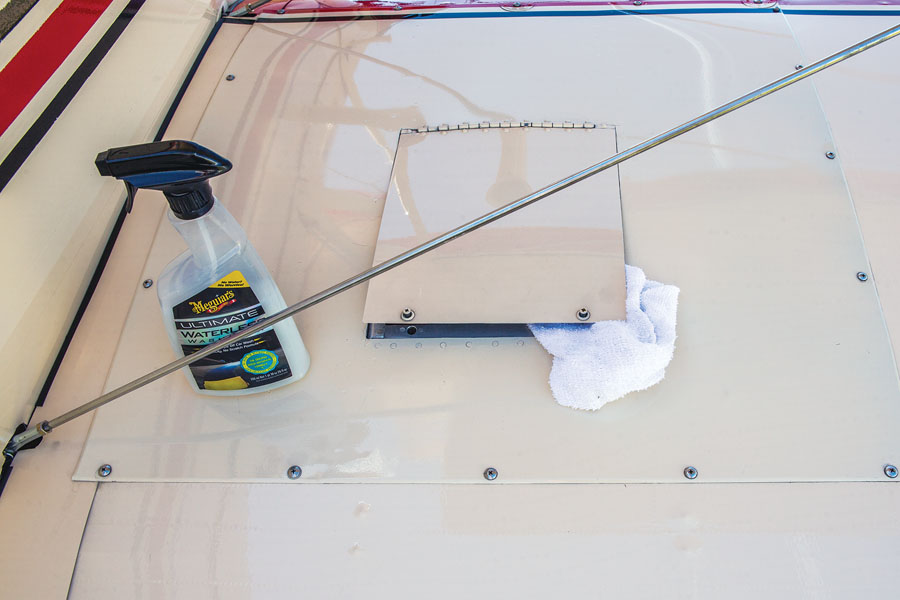
On the lower right wing, they turned the tank area into a storage locker, important in an airplane with no meaningful baggage area.
About that Tank Engine
“When I was learning to be an A&P 35 years ago, doing OJT with a gentleman who opened up a small grass strip that had been abandoned for 35 years, I found it in one of the buildings I was cleaning,” said Belcher. “The crate was deteriorated, but the engine was brand new. It was a tank engine, and the son of the airport’s original owner said his dad bought it surplus in 1946.”
Following the ancient law of findings keepings, his boss told Belcher to take the tank engine with him three years later when he took the next step in his career. “I’d never monkeyed with round engines before,” said Belcher, so he put the potential training aid “in my barn and didn’t look at it for 40 years.”
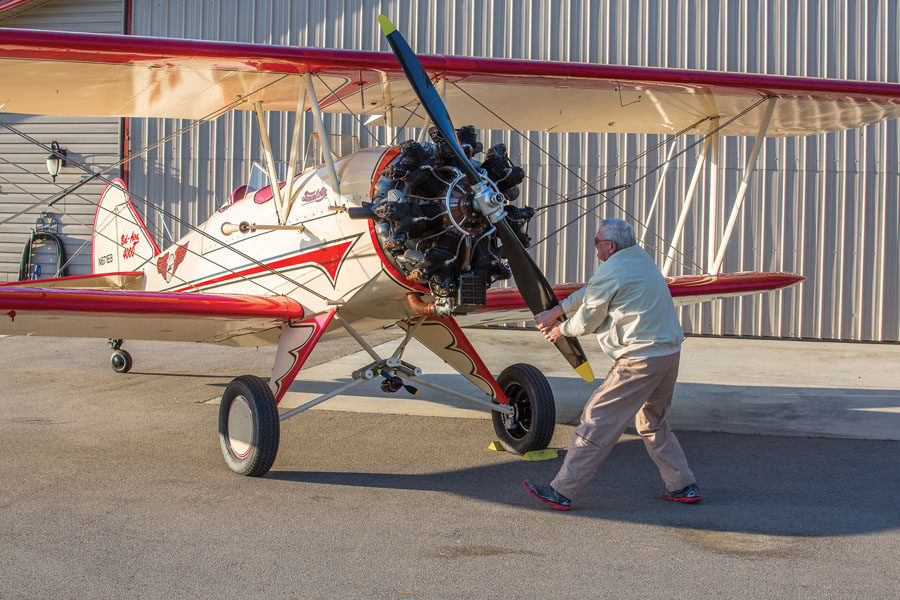
Bill Bardin pulls the prop through before taking off from his winter home at the Gilliam- McConnell Airport in Carthage, North Carolina.
Then his older brother Glen discovered it, asked about the big tank mounting ring, and what Belcher planned on doing with the engine. Not seeing any missing parts, he thought he could make it run. A talented car and truck engine guy, “I thought he was kidding.” He wasn’t. He built a test stand and went to work. “He got it running in one weekend,” said Belcher.
“After that, we bought a certified W670, and Joe Hunt put them together in one engine.” Resting his hand on the engine, Belcher said, “This engine has parts from the tank engine. My brother has since passed; it’s a tribute to him.”
It took some work to find the certified prop. With factory-adjustable pitches, they work on a variety of WW-II era engines. “There weren’t many left because they were popular with crop dusters,” said Belcher. “This is a 104-inch prop. Dusters often shortened them with a saw to improve ground clearance when they were squatting on the gear with a full hopper.”
With a full 12-volt electrical system and 30-amp generator, a starter makes the engine go, said Belcher. “We stayed with the same old Stearman primer system, but it has a more modern ignition system, switches, and sensors. To keep the battery in top form, the battery charger plugs into a dedicated fuselage receptacle. “We’re gonna put lights on it, with a strobe on the bottom,” said Bardin.
In the cockpit, “we used the same six-pack instruments you’d find in any Cessna.” Instead of the curved, one-piece Travel Air windshields, the partners found the three-pane Stearman frames at the Oshkosh Fly-Mart. “They are a little more stylish,” said Belcher, “and they give the airplane a unique character.”
In the end, said Belcher, “We were lucky.” But they made their luck. To set a baseline, they studied the original airplane and collected all the pertinent historical information they could find and glean from Travel Air aficionados. And then they adjusted. “We didn’t have a lot of tearing out once we figured it out, the thrust line and all that stuff; we jigged it up in the hangar.”
“The project took seven years, with 50 percent done in one year,” said Belcher. “We worked part time, when we’d get a few nickels together.”
First Flight
Bardin made the first flight at Belcher’s 2800-foot grass strip right after the DAR inspected the airplane and signed its airworthiness certificate on June 14, 2017. Belcher made his first flight a couple of weeks later, after Bardin finished the 25-hour Phase I test period, and said, “It’s a two-finger flyer that’s solid as a rock—no shuddering or shaking.”
“We really don’t have any plans for the airplane,” said Belcher. “Eventually, it might get shoved into the barn, but I think it’s a good enough idea that I’d really like someone to buy the airplane, all the jigs, our knowledge, and build it as a kit. It’s not that hard. With all of the welding done, as a kit it would be a simple airplane. At this point, it’s a toy. We’re going to fly it a lot and have fun with it.”

